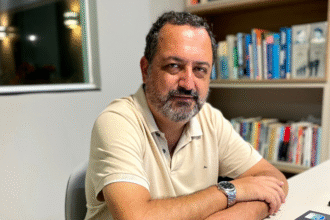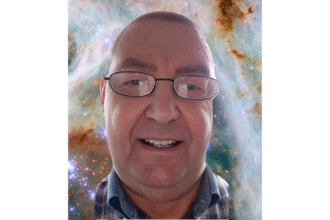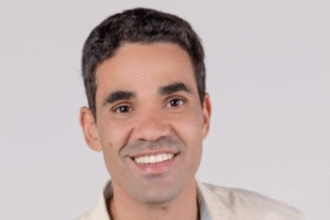“O Homem da Patagonia” mixes fiction, history and conspiracy theories, and takes the reader to Buenos Aires in the late 1950s
Journalist Paulo Stucchi uses Nazism and World War II as a backdrop for his main books, including A Filha do Reich, a finalist for the Jabuti Prize. The theme, which became the author’s hallmark, is back in O Homem da Patagonia, published by Jangada publishing house. In his new book, the stage of history is not the European continent or the interior of southern Brazil, but the country that harbored the most Nazis, after the USA: Argentina.
In the plot, a disturbing psychological thriller set in 1958 Buenos Aires, Sebastián Lindner, a renowned Argentine psychologist, is hired by a young German woman to treat her father, an old Nazi refugee who lives in a remote fortress in Patagonia and whose personality is shrouded in many mysteries. As the mysterious patient’s memories are accessed, Dr. Lindner is faced with an ancient and terrible secret – which dates back to Hitler’s final days in a bunker in Berlin and which could drastically change the course of post-World War II history. In a personal dilemma, the psychologist begins to confront the worst face of evil and face his own demons.
Step by step, between therapy sessions and new revelations of real and fictional characters, the reader will discover, together with psychologist Sebastián Lindner, who the mysterious old German is, and will delve into the same doubts about the character: after all, would he be facing Adolf Hitler himself – one of the most important and abhorrent characters in world history? Check out the interview!
Considered one of the darkest moments from 1933 to 1945, Nazi Germany was responsible for the extermination of thousands of people and until today is referenced by its historical landmark in several productions and literary works, such as his book “A Filha do Reich”, which was a finalist for the Jabuti Award, and the most recent “O Homem da Patagonia”. Addressing such a sensitive topic as this was a complicated task?
I think it’s an important task because, despite the fiction involved in both projects, many facts are true. And bringing these atrocities to light is a way of making people not forget how far human evil can go.
In relation to his works, this theme is strongly present in all of them, and in this new book, the story takes place in Argentina, the country that sheltered the Nazis after passing through the United States. How much time and what were the writing and research techniques required to produce these two works and why did the theme attract you so much?
Perhaps it was the book that most required me to research. Not just about the post-war period, but about Argentina in the 1950s, its history. Regarding the subject itself, I have always enjoyed reading and researching Nazism. It attracts me to question how such a nefarious ideology attracted and united so many people.
Considered a psychological thriller, the narrative of his book was seen as disturbing, mainly due to its context, which would be that of psychologist Sebastián Lindner, who was hired to treat the father of a young German woman, who in this case would be a Nazi refugee. When bringing this story to life, did you think about the sensations that Sebastián would go through if this story were true in his life?
Yes definitely. I am also a psychoanalyst, so some of the Freudian techniques I describe in the book are real, possibly would have been used by me if I were in Dr. Lindner (laughs). It is always important to remember that the therapist is not an island; he is a human being as his own questions. Often, cases brought by patients affect the therapist so that he himself needs to review things within himself. We call this countertransference. That’s why I chose to create Sebastián Lindner as a man with his own dilemmas and demons, who finds himself in a dangerous vortex when faced with the possibility of treating someone that many consider the embodiment of evil, like Hitler. Interestingly, many people who read the book prior to its release highlighted that there is no good guy or bad guy in the story, even though some seem to have those roles. When writing about human nature, Manichaean ideas cannot be taken into account. I tried to put that into practice in the storyline as well.

At a certain point in history, Lidner ends up having access to several memories of his patient, and one of them shows how Hitler’s last days in a bunker in Berlin could have changed the course of the post-Second War. This was certainly one of the highlights of the story, and how was the introduction of this discovery made in the book? Do you believe that there is still a lot of Nazi history that can still be discovered by the world?
Hitler’s last day in his bunker opens and closes the story, pretty much. The whole plot revolves around what would have actually happened in the last hours of the Führer in his bunker, and leads the reader to reflect on what the post-war reality would be like if, in fact, Hitler had survived. The fact is that they did not find a body – theoretically, his and Eva Braum’s corpses were incinerated by Soviet soldiers. The objective was never to tell a story in which Hitler survived the fall of Berlin, but rather to make the reader reflect on the consequences of this possibility – which is never evident in the book.
After a while in this situation, the psychologist starts to confront his worst evil face and faces his own demons, and little by little, the narrative makes the reader go through a submersion, where in the end, it makes him wonder if he was facing Adolf Hitler in person. Paulo, when writing this book, as much as it is your own writing, what were the thoughts that sprouted in your head during the construction of this narrative?
I never wrote with certainty whether Albert Leipzig was Hitler or not. The same doubt that was in me throughout the 512 pages, I want the reader to have. I didn’t hide anything in the narrative, I also kept myself in the dark throughout the process (laughs). The important thing, as Mr. Leipzig says, it is not whether the Führer survived or not, but that his dream remained alive. And, as the recent history of the world and Brazil proves, the extreme right is more alive than ever. It is still easy, almost ridiculous, to manipulate people around outlandish ideas; why not, then, cause them to die and kill? This is the question that Dr. Lindner must have had, and I hope the reader does too.
Regarding this possible identification of the elderly with the image of Adolf Hitler, in a possible scenario, after all, in April it will be 78 years since his death, what would you have to say to him today and what would be your reactions to a meeting with the dictator?
I pray that Hitler really did meet his end on April 30, 1945. The world doesn’t need people like him, despite all his charisma. Today’s Brazil knows what it’s like to create a myth around a person with a limited intellect, someone on the verge of being silly; this is harmful. Any dictatorship, left or right, is. I think that, to answer your question, the important thing would not be what I would say to a dictator, but to other people. I think it would say something like “stand up and open your eyes!”. There is no leader without followers.

Although many people always associate Nazism only in Europe, its presence in South America still demanded some searches and readings about the presence of the movement in the continent. How did the idea to start writing the books come about? Do you still intend to release a third volume on the subject?
Shifting the focus of Nazism from Europe to South America aimed to show how this ideology actually extended its tentacles around the world. There was a real project to perpetuate Nazism and rebuild a Fourth Reich. South America had an important strategic role due to its wealth. The Nazis were in the Amazon, in the interior of São Paulo, in Paraguay, in the north of Argentina and in Patagonia; its engineers and scientists were welcomed by the USA and the Soviet Union and it is known that they played a very important role in the development of special programs and medical studies. So, the seed of Nazism was never exterminated, even if its ideology was fought.
Regarding all this construction of the book, it is clear that while some elements were constructed and characters were created, many elements also have real references to our history. However, how much do you believe that the stories in this book are real and do you believe that Nazism, even if it is proven to be devastating as it has been in our history, it can still have a strong influence on the minds of many people?
Nazism occasionally shows its face in Europe or even America, often disguised as nationalism. Many of the facts of “Man from Patagonia” are real, including Nazi characters who took refuge in Argentina and lived as farmers and politicians. And it wasn’t just there; to this day, one discovers Nazis living under other names, who have remade their lives, built families. It is worth remembering that, although Nazism is something terrifying, what the Soviet Union did with the conquered peoples was not far behind; many judge Stalin worse than Hitler. So, no matter what name you give it – Nazism, Soviet-style communism, China’s cultural revolution. Behind everything, there is human evil, the destructive potential that we have in us.
Follow Paulo Stucchi on Instagram





